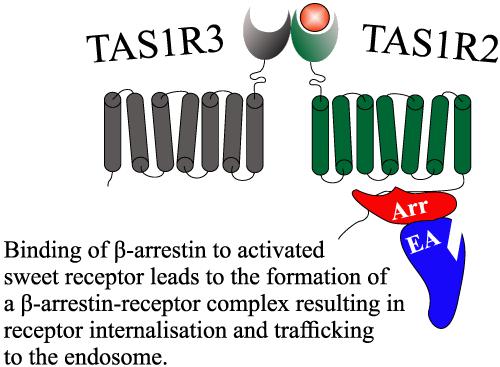当前位置:
X-MOL 学术
›
Flavour Frag. J.
›
论文详情
Our official English website, www.x-mol.net, welcomes your feedback! (Note: you will need to create a separate account there.)
A novel functional screening assay to monitor sweet taste receptor activation in vitro
Flavour and Fragrance Journal ( IF 2.6 ) Pub Date : 2017-11-21 , DOI: 10.1002/ffj.3431 Shanna Bastiaan-Net 1 , Dianne B.P.M. van den Berg-Somhorst 1 , Renata M.C. Ariëns 1 , Marcel Paques 2 , Jurriaan J. Mes 1
Flavour and Fragrance Journal ( IF 2.6 ) Pub Date : 2017-11-21 , DOI: 10.1002/ffj.3431 Shanna Bastiaan-Net 1 , Dianne B.P.M. van den Berg-Somhorst 1 , Renata M.C. Ariëns 1 , Marcel Paques 2 , Jurriaan J. Mes 1
Affiliation

|
The human sweet taste receptor is a heterodimer comprised of the class C G protein‐coupled receptor (GPCR) subunits TAS1R2 and TAS1R3. A wide collection of sweet tasting compounds and modulators of sweet taste interact with this receptor. Although TAS1R2/TAS1R3‐mediated signaling is well‐studied, the molecular basis for its desensitization remains unclear while such knowledge would signify a profound step forward in understanding the mechanism behind sweet taste perception and taste modulation. In this work, the possible involvement of β‐arrestin in downstream signaling was investigated. A stable clonal Human Embryonic Kidney (HEK)‐derived cell line containing the PathHunter™ GPCR technology was developed, in which β‐arrestin‐mediated endosomal receptor internalization can be monitored by ligand‐induced enzyme complementation of β‐galactosidase (β‐gal). Stimulatory responses and antibody‐specific receptor detection indicated that the TAS1R2/TAS1R3 receptor is endogenously expressed in this clonal cell line. Natural sugars (including fructose, glucose, sucrose, maltose, maltitol and mannitol) and artificial sweeteners (acesulfame‐K and sucralose) stimulated enzyme complementation activity in a concentration dependent manner. Besides, we observed that the assay detected modification of sugar induced cell responses by sweetness enhancers. These results combined implicate that TAS1R2/TAS1R3 receptor desensitization by internalization is most likely mediated by β‐arrestin‐induced endocytosis. This assay approach, making use of naturally expressed TAS1R2/TAS1R3 receptors and required co‐factors, further allows effective screening for and development of novel high potency non‐caloric sweeteners, sweet taste modulators or optimal blends with enhanced sweet taste.
中文翻译:

一种新颖的功能筛选测定法,可在体外监测甜味受体的活化
人的甜味受体是一种异源二聚体,由CG类蛋白偶联受体(GPCR)亚基TAS1R2和TAS1R3组成。各种各样的甜味化合物和甜味调节剂都与该受体相互作用。尽管已经对TAS1R2 / TAS1R3介导的信号传导进行了深入研究,但对其脱敏作用的分子基础仍不清楚,尽管此类知识将表明在理解甜味感知和味觉调节机制方面迈出了重要的一步。在这项工作中,研究了β-arrestin在下游信号传导中的可能参与。开发了包含PathHunter™GPCR技术的稳定的人类胚胎肾脏(HEK)克隆细胞系,其中β-arrestin介导的内体受体内在性可以通过配体诱导的β-半乳糖苷酶(β-gal)的酶互补作用进行监测。刺激反应和抗体特异性受体检测表明,TAS1R2 / TAS1R3受体在该克隆细胞系中内源表达。天然糖(包括果糖,葡萄糖,蔗糖,麦芽糖,麦芽糖醇和甘露醇)和人造甜味剂(乙酰磺胺酸钾和三氯蔗糖)以浓度依赖的方式刺激酶的互补活性。此外,我们观察到该测定法检测到甜味增强剂对糖诱导的细胞应答的修饰。这些结果综合表明,TAS1R2 / TAS1R3受体通过内在化作用脱敏的可能性最大可能是由β-抑制蛋白诱导的内吞作用介导的。这种测定方法
更新日期:2017-11-21
中文翻译:

一种新颖的功能筛选测定法,可在体外监测甜味受体的活化
人的甜味受体是一种异源二聚体,由CG类蛋白偶联受体(GPCR)亚基TAS1R2和TAS1R3组成。各种各样的甜味化合物和甜味调节剂都与该受体相互作用。尽管已经对TAS1R2 / TAS1R3介导的信号传导进行了深入研究,但对其脱敏作用的分子基础仍不清楚,尽管此类知识将表明在理解甜味感知和味觉调节机制方面迈出了重要的一步。在这项工作中,研究了β-arrestin在下游信号传导中的可能参与。开发了包含PathHunter™GPCR技术的稳定的人类胚胎肾脏(HEK)克隆细胞系,其中β-arrestin介导的内体受体内在性可以通过配体诱导的β-半乳糖苷酶(β-gal)的酶互补作用进行监测。刺激反应和抗体特异性受体检测表明,TAS1R2 / TAS1R3受体在该克隆细胞系中内源表达。天然糖(包括果糖,葡萄糖,蔗糖,麦芽糖,麦芽糖醇和甘露醇)和人造甜味剂(乙酰磺胺酸钾和三氯蔗糖)以浓度依赖的方式刺激酶的互补活性。此外,我们观察到该测定法检测到甜味增强剂对糖诱导的细胞应答的修饰。这些结果综合表明,TAS1R2 / TAS1R3受体通过内在化作用脱敏的可能性最大可能是由β-抑制蛋白诱导的内吞作用介导的。这种测定方法



























 京公网安备 11010802027423号
京公网安备 11010802027423号